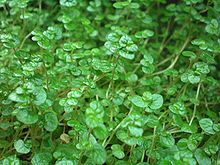Soleirolia
| Soleirolia soleirolii | |
|---|---|

| |
| Scientific classification | |
| Kingdom: | |
| (unranked): | Angiosperms
|
| (unranked): | |
| (unranked): | |
| Order: | |
| Family: | |
| Genus: | Soleirolia |
| Species: | S. soleirolii
|
| Binomial name | |
| Soleirolia soleirolii | |
| Synonyms[1] | |
|
Helxine soleirolii Req.
| |
Soleirolia soleirolii (/soʊˌliːəˈroʊliə soʊˌliːəˈroʊliˌaɪ, ˌsoʊlɪˈroʊ-/,[2][3] syn. Helxine soleirolii) is a plant in the nettle family. It has a number of common names, including baby's tears, angel's tears, peace in the home, bits and pieces, bread and cheese, Corsican creeper, Corsican curse, friendship plant, mind-your-own-business, mother of thousands, Paddy's wig, and pollyanna vine.[4] It has also been called Irish moss; however, it is not a moss, nor should it be confused with Sagina subulata or Chondrus crispus (an alga), which are also known as "Irish moss".
Description[]
It is a delicate-looking creeping herb with juicy bright green or yellow leaves and multitudes of tiny white flowers. It grows close to the ground in mats and is sometimes used in ornamental gardens alongside ferns and other moisture-loving types of plant.
The leaves are usually slightly stalked, about 5 mm across. The minute flowers produce oval seeds.[5]
Distribution[]
This species is native to the northern Mediterranean region[5] in and around Italy and nearby islands, but it has been introduced and cultivated nearly worldwide as an ornamental and garden plant. It has been recorded from the north east of Ireland in counties Antrim and Down.[6]
Habitat[]
It can be grown indoors as a houseplant and used in habitats for amphibians. It prefers shade and moderate moisture. It can even grow submerged in swampy environments. In colder regions, the plant dies back during winter, but it returns with lush growth as the temperature increases. It is capable of vegetative reproduction, so to eradicate it once it has become established in an area, the entire plant must be removed, or else it can sprout new growth. It is a common weed in many places.[7] Nurseries grow several varieties, including gold, yellow, and white breeds, but the mossy-green type is most popular with gardeners.
This species, the only member of the monotypic genus, Soleirolia,[8] was named after the French army engineer and plant collector Henri-Augustin Soleirol by his fellow French naturalist Esprit Requien. Soleirol, an amateur botanist, originally collected the plant in Corsica. [9]
References[]
- ^ The Plant List
- ^ Sunset Western Garden Book, 1995:606–607
- ^ "Pronunciation Guide". Fine Gardening. Retrieved 2016-01-23.
- ^ "Soleirolia soleirolii - Plant Finder". www.missouribotanicalgarden.org. Retrieved 2018-11-25.
- ^ a b Parnell, J. and Curtis, T. 2012. Webb's An Irish Flora. Cork University Press. ISBN 978-185918-4783
- ^ Hackney, P. (ed) 1992. Stewart and Corry's Flora of the North-east of Ireland third edition. Institute of Irish Studies and The Queen's University of Belfast. ISBN 0-85389-446-9
- ^ "Mind-your-own-business". Royal Horticultural Society. Retrieved 6 April 2015.
- ^ David E. Boufford (1997). "Urticaceae". Magnoliophyta: Magnoliidae and Hamamelidae. Flora of North America. Vol. 3. Oxford University Press. pp. 400–413. ISBN 978-0-19-511246-7.
- ^ Patrick Bungener & Daniel Jeanmonod. Les frères Soleirol, histoire séculaire d'une confusion autour d'un collecteur en Corse. Candollea. volume 74. pages. 209-216. 2019. [1]
External links[]
 Media related to Soleirolia soleirolii at Wikimedia Commons
Media related to Soleirolia soleirolii at Wikimedia Commons
- Urticaceae genera
- Monotypic Rosales genera
- Flora of Italy
- Urticaceae
- Groundcovers